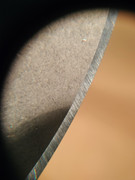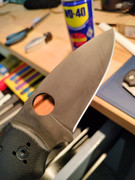Hi together,
I had some time to repeat the tests.
I sharpened a S30V Shaman, 1000grit Diamond on a guided system (17dps). There definately is a burr right off the system, there is no way to avoid that. I did very light strokes in the end to minimize the burr.
After that, I did 3 edge leading strokes on a fine Spyderco Gauntlet rod, maybe 1 or 2 degrees higher than the system angle, trying to knock off the burr. After that the knife was able to easily shave off arm hair in both directions.
After that, I stropped on a kangaroo strop loaded with 1.5 micron KME CBN emulsion. I guess that I removed any burrs. The knife was able to cut hair in half, but I needed a relative movement along the edge to cut it.
By feel I would say that the edge was quite aggressive and very sharp.
Here pictures through a 15x loup (not the best picture quality), after the stropping:


Then I cut approx. 25ft of heavy carboard:

That was the point the knife stopped shaving armhair cleanly. The edge started to reflect light. It was still able to cut phonebook paper quite good.
Here you can see a little edge damage:

I also had a S30V Shaman NIB (DLC). That knife acted exactly the same as the Shaman I sharpened before. As you can see, that carboard was quite abrasive as the DLC got damaged (it is actual wear and no residue) after cutting 25ft of the mentioned cardboard.

Now the final question, do you think I had a burr left after my progression? Could I do something else to increase wear resistance, or is it within normal range?
Thanks and best regards,
Oliver





